
I N D I A
NOTE: "HOME" takes you to our
initial home page; "UP" will return you
to the Round The World 2008 site
for more exploring.
If you want to skip ahead, just click on one of
these links:
Mysore & Central India
Chennai & The South
Mumbai & Aurangabad
Udaipur,
Jodphur & Agra (The Taj Mahal)
Khajuraho & Varanasi
New Delhi
Sat, 19 Oct: We arrived at our first stop in India, Kolkata, at 9:30AM. After clearing immigrations and customs, we exited the airport. We had a bit of a mishap in that there was no travel representative waiting for us. One individual tried to take us to his car but he didn’t know the hotel at which we were scheduled to stay so no go there. An Indian guide who was escorting a small group assisted us and found the driver who was supposed to take us into town. Again, no representative but a start. The driver spoke some English, so during the 22KM ride to our hotel, he explained the various parts of town we passed through. During the drive, a representative from the tour company called and apologized for missing us at the airport. After we checked into the hotel, the representative came by and met shortly with us.
At 12:00 noon, we went touring with our guide, Mrs. Singha, for the balance of the day. We first took a driving tour through the city. We began with a look at various government buildings. Most of these were constructed during British occupation. We then went to the Victoria Memorial. The building is built of white marble and was dedicated on December 28, 1921. It houses historical photographs of Kolkata as well as oil paintings of British occupiers (no photographs were allowed inside). We next drove through various ethnic neighborhoods en route to the banks of the Ganges River. Finally, we went to the complex where Mother Theresa worked to feed the poor of Kolkata. It included a museum which showed the history of her work. We were allowed to take a photograph of the tomb where her body now lays. We ended our touring with Mrs. Singha late in the day. Afterwards, we walked to the New Market, a short block from our hotel. It is a collection of vendors who hound shoppers to visit their stores/stands. We finally escaped into a department store located nearby where we bought some cold drinks and returned to the hotel. It was a very full but enjoyable day.
Click on the image to display a larger photo. Once
displayed,
click on the BACK button (first button on the left of your browser)
to return to this page.
 |
Victoria Memorial |
 |
The mighty Ganges River |
 |
A traditional boat on the
Ganges in front of the modern city |
 |
Mother Teresa's tomb |
Mon, 20 Oct: Today we were on our own. So, we enjoyed a very leisurely breakfast at the hotel. Then, we wandered nearby streets which were filled with individuals selling goods they carried on their backs and then displayed from make-shift stands. We did do some shopping (can’t miss out on that!) and found some great bargains. Late in the day, we returned to the hotel. We brought with us a dinner of vegetarian momo (dumplings) to enjoy in our room.
Click on the image to display a larger photo. Once
displayed,
click on the BACK button (first button on the left of your browser)
to return to this page.
Tues, 21 Oct: We had another relaxing breakfast before doing some more strolling on the streets. Unfortunately, it can get a bit tiring because of the relentless hawkers trying to get you to go to various shops. They aren’t nearly as bad, however, as some beggars who follow you, push you, pull on you and anything else they can do to get a few coins. Of course, we all know “change doesn’t make a change” so no coins from us. It’s always best to donate via a charity where you know the funds will be put to good use. So, we returned to the hotel and relaxed until our transfer to the airport for a late afternoon flight to Hyderabad. We arrived in Hyderabad at 8:05PM in the city’s beautiful new airport. Our transfer agent (with a sign board with our name) was waiting as was our driver. We arrived at our hotel, the Taj Banjara, at 9:30PM and were shown to a HUGE room. Wow! We relaxed over a cold beverage and called it a day at 11:00PM.
Wed, 22 Oct: Again, breakfast was a real treat. After enjoying ourselves from 8:00AM until 9:00AM, we went touring with our guide, Madhu and our driver from the previous night, Shariff. Our first stop for the day was the ancient Golcanda Fort. It sits high above Hyderabad about 11KM away from Old Hyderabad. It served as the capital and residence of the Qutab Shahi Kings from 1518 until the end of the 16th century. During this time, there were seven kings, all of whom were Muslim. We walked into the complex via one set of stairs and out the complex via another. The Fort consisted of the living quarters for the Kings and their families as well as their military guards. Also, within the immediate complex there was a complex of diamond dealers, several mosques and a Hindu temple. An outer wall to further protect the Fort walls enclosed some 7KM of additional land surrounding the Fort and provided for its initial defense as well as protection for the common people.
Click on the image to display a larger photo. Once
displayed,
click on the BACK button (first button on the left of your browser)
to return to this page.
 |
A map of the Golcanda Fort complex |
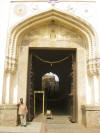 |
Balahissar Gate |
 |
One of the many passageways |
 |
Quatab Shahi Mosque |
 |
Looking down at the complex from the King's residences |
We next went to visit the cluster of tombs which were the final resting places for all but the last king of the Qutab Shahi Kings (his tomb was unfinished when he was overthrown). Most of the tombs were constructed by the Kings in advance of their death. One particularly large tomb was built for the Fatima, the 4th King’s sister.
Click on the image to display a larger photo. Once
displayed,
click on the BACK button (first button on the left of your browser)
to return to this page.
We then drove across town to visit the Salar Jang Museum. It houses a huge group of articles collected by Salar Jang, his son and his grandson. Our favorite parts of the exhibition included a statute of Rachel in which she is draped in a veil which appears to be made of cloth rather than part of the marble. The second was a wooden statute which had a male figure on the front and a female figure on the back. Both were very amazing! We also enjoyed the beautiful carved ivory and immense collection of statutes of Hindu Gods.
Several blocks away, we entered the predominantly Muslim area in Old Hyderabad. There was a huge street market with vendors selling all types of fruits and nuts just off the street. In the center of the street area was the Charminar, a triumphal arch built at the city center of the Old City by King Quil Shah. Very near to the Charminar is Mecca Masjid, the sixth largest mosque in India, constructed by 1598 by King Abdullah Qutan Shah. The mosque was very busy and we learned that pigeons are fed there when someone has a sick relative in hopes that the relative will recover. Lastly, we walked through a bazaar where bangle bracelets are the primary item being sold. It was amazing to see blocks of bangles and other jewelry.
Click on the image to display a larger photo. Once
displayed,
click on the BACK button (first button on the left of your browser)
to return to this page.
 |
A typical street in Old Town with lots of "tuk, tuk's" |
 |
The Charminar Arch |
 |
The towers of Mecca Masjid |
 |
The bazaar at the base of The Charmimar |
We returned to the Taj Banjara at 5:30PM after a very enjoyable and informative day in Hyderabad. We enjoyed a delicious glass of wine in the hotel bar (compliments of the hotel) and then spent the balance of our evening relaxing.
Thur, 23 Oct: Today we were on our own with our car and Shariff, its driver, at our disposal. Based on discussions the previous day, we decided to only go out for a couple of hours. First, we went to a beautiful modern Hindu Temple built in honor of Lord Vishnu on the hills of Hyderabad by the Birla Family. It was made entirely of white marble. No photographs were allowed inside but it was just as beautiful as the outside that we were able to photograph. Next, Shariff drove us around the Lake Hussain Sagar which serves as the dividing area for Old Hyderabad and New Hyderabad. In its center is a large statute of Buudda. Next, we did some essential shopping. First, we stopped at a grocery store to get some items and then we went to a liquor store and bought Indian rum. Shariff returned us to the hotel at 12:00PM where we relaxed, began repacking and enjoyed the balance of our time in Hyderabad.
Click on the image to display a larger photo. Once
displayed,
click on the BACK button (first button on the left of your browser)
to return to this page.
M Y S O R E &
C E N T R A L I N D I A
Fri, 24 Oct: This was once again a travel day. We left the hotel at 9:00AM for an 11:30AM flight to Bangalore, some 600KM to the south. When we arrived, we were met by a tour representative. He introduced us to our driver, Boopeti, who was to transfer us to the town of Mysore, then the town of Hassan and finally back to the airport.
We began the 2.5 hour drive from Bangalore to Mysore. The first 1.5 hours were spent on the ring road around Bangalore. Then, we entered the countryside for the first time. It was quite the contrast to the huge cities we had seen up until this time. There were rice paddies, fields of sugar cane, lots of cows and several oxen-drawn carts. Unfortunately, as we neared Mysore, the rain began to fall and it slowed us down a bit. We did take time to stop at a factory specializing in wooden inlay handicrafts. There we bought a beautiful carving featuring two peacocks. After that, we headed to the Metropole Hotel. There we met Pushba, our guide for the following day. Then, we settled in for the night and relaxed after the long day.
Sat, 25 Oct: Our touring began at 9:00AM. First, we visited Sri Rangapatnam (Temple Rangapatnam), a Hindu temple devoted to Lord Shiva. We took photographs of the outer walls and outer courtyard. True to what we had seen on National Geographic, a group of monkeys occupies the temple and are protected there. So, we took our first shot of one of these devotees.
Click on the image to display a larger photo. Once
displayed,
click on the BACK button (first button on the left of your browser)
to return to this page.
We next went to see the remains of Lal Mahal Palace. It was here that Sultan Tipu was defeated by the British and lost his life during the battle for the Palace. Before its fall, the Palace contained a prison where captured British soldiers were chained to the walls. Not a nice place! Our next stop was Tipu’s Tomb. It was in the same style as the tombs of the Muslim kings of Hyderabad. The tomb contains the bodies of Tipu and his parents. Inside the complex adjacent to the tomb is a small mosque.
Click on the image to display a larger photo. Once
displayed,
click on the BACK button (first button on the left of your browser)
to return to this page.
En route to the Chamundi Hill, which rises some 1026 meters above Mysore, we stopped along side the road to see sugar cane being processed into sugar. First, the juice was extracted; then it was boiled; the mixture was cooled; and finally cut into blocks of sugar. Our guide, Pushba, bought some to take home. However, since it isn’t a very sanitary process, she boils the end product and returns it to syrup which she then uses in cooking. Also, we happened upon one of the many colorful oxen carts which still are used for transport today.
Click on the image to display a larger photo. Once
displayed,
click on the BACK button (first button on the left of your browser)
to return to this page.
When we arrived at the summit of Chamundi Hill, we saw the beautiful Chamundewari Temple. Its highlight is a seven story tower which rises 40 meters high. Below the temple is a Nandi (Lord Shiva’s Bull) which was carved in place out of a single granite boulder in 1659.
Click on the image to display a larger photo. Once
displayed,
click on the BACK button (first button on the left of your browser)
to return to this page.
We next visited the Mysore Palace. It is partially open to the public as some areas are still living quarters for the former royal family. The Palace has beautiful grounds and the rooms which we visited had numerous paintings collected over the years. The original palace was burnt down in 1897 and the present one was completed in 1912.
Click on the image to display a larger photo. Once
displayed,
click on the BACK button (first button on the left of your browser)
to return to this page.
Our final stop for the day was the Mysore vegetable market. It was packed with individuals making purchases prior to the Festival of Divali (Festival of Lights celebrating Shiva’s defeat of a demon). We then returned to the hotel where we said goodbye to Pushba and settled in for the night.
Click on the image to display a larger photo. Once
displayed,
click on the BACK button (first button on the left of your browser)
to return to this page.
Sun, 26 Oct: Our day began early with our driver, Boopeti, taking us to the small town of Shravanabelogola (pop. 8,000). Here we met our guide for the day, Mugesh. At the town we walked up a flight of 600 steps carved into the face of a granite hill to visit the giant statute of Gommateshvara. The 17 meter statute, made on site from the surrounding granite, and the accompanying temple area dedicated to the Jain sect of the Hindu religion. It was very impressive!
Click on the image to display a larger photo. Once
displayed,
click on the BACK button (first button on the left of your browser)
to return to this page.
Next we drove to 12th century Hindu temple at Belur known as Channakeshava Temple, dedicated to the Hindu god, Lord Shiva. This temple, which is built of soapstone, is covered with endless rows of carvings (big and small). It was begun in 1117AD and took over 100 years to complete because of the intricate details. It was simply amazing and the carvings were incredibly beautiful. You could spend days just admiring the workmanship!
Click on the image to display a larger photo. Once
displayed,
click on the BACK button (first button on the left of your browser)
to return to this page.
 |
Channakeshava Temple |
 |
The symbol of the Hoysola
Kings |
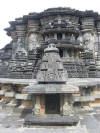 |
A temple to Lord Vishnu with a small temple in front |
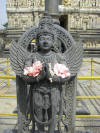 |
A "Garuda" which protects the Temple |
Our next stop was only 13KM away. There is the Hoysaleshwara Temple in the town of Halebid. Halebed was the capital of the area until the city was destroyed by Muslin invaders in the 14th century. The temple, which is dedicated to the Hindu god, Lord Shiva, sustained damage but it still quite magnificent. It too was built in the 12th century.
Click on the image to display a larger photo. Once
displayed,
click on the BACK button (first button on the left of your browser)
to return to this page.
 |
The entry to Hoysaleshwara Temple |
 |
Carvings on the Temple walls |
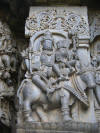 |
Lord Shiva (Destroyer God), his wife, Parvati (Goddess of Power) and Nandi |
Our guide left us at Halebid to return home. Boopeti drove us to Hassan, our home for the night.
C H E N N A I & T H E S O U T H
Mon, 27 Oct: Today was primarily a travel day for us. Boopeti picked us up early for the drive back to Bangalore which took about 5 hours. Today was a government holiday for Divali so Boopeti gave us a quick city tour. Then, we headed out for the airport. Normally a 1-1.5 hour drive, it took only about 45 minutes. There we boarded our flight to Chennai. We arrived in Chennai at 5:00PM where we were met by our transfer agent and driver. Given it was late and all monuments closed for the holiday, we did no touring. Instead, we walked around our neighborhood enjoying the celebration of lights and fireworks. We had some cold beer in the hotel lounge along with some great snacks and then returned to our room to enjoy the continuing views of the fireworks.
Tue, 28 Oct: The city was no longer on holiday but we were! So we had a relaxing breakfast and then went into town for a bit of shopping. At 2:00PM our driver, Kadhar, who will be with us until 9 November, arrived at the hotel with our guide, Srider. We drove around town to see a few highlights. We first saw the beach located within the city. Then, we visited Fort George and its British Museum. Next, we visited the Anglican Church. Finally, we drove to St. Thomas’ Catholic Basilica. Then, we called it a day to once again enjoy the Diwali festivities.
Wed, 29 Oct: This morning Kadhar picked us up at 8:00AM because we had a day of both driving our touring. We picked up Srider at 9:00AM en route to Kanchipuram, which was one of India’s seven sacred cities under the Pallavas. The Pallavas reigned from the 6th – 8th centuries in this area. The city contains more than 1,000 Hindu temples. We visited two primary temples: Devarajaswamy and Ekambaranathar. The Devarajaswami temple is know for its elaborately carved pillars. The main hall is dedicated to the wedding of Lord Shiva and Goddess Parvati. Ekambareshwara Temple, the largest temple in Kanchipuram, is dedicated to Lord Shiva. The temple, which sprawls over 9 hectares, has a 1,000 pillared hall and a 3,500 year old mango tree (the tree recently died but from its roots a new mango is growing). Lastly, we visited a temple outside of town (we don’t know the name). Here part of the temple has been restored to contrast its original state to its current state. Again, great!
Click on the image to display a larger photo. Once
displayed,
click on the BACK button (first button on the left of your browser)
to return to this page.
We next visited a silk factory where saris and other silk garments have been hand-loomed for centuries. It was an amazing to watch the process and see the amount of time required to create such fine detail. We next drove to our home for the next two nights, Mahabalipuram, located on the Bay of Bengal, some 60KMs south of Chennai. We checked into the beautiful GRT Temple Bay Resort and then continued on with our touring.
Click on the image to display a larger photo. Once
displayed,
click on the BACK button (first button on the left of your browser)
to return to this page.
We went to a site where the Ancients tested several techniques for temple building. They initially worked on carving these creations in various granite outcrops. Also, they worked on what is believed to be one of the longest open air bas relief workings in the world. Then, the Ancients moved to another area which is now known as the Five Rathas. Here they created a set of monolithic rock temples. A total of five temples were carved and three animal images (a lion, a bull and an elephant).
Click on the image to display a larger photo. Once
displayed,
click on the BACK button (first button on the left of your browser)
to return to this page.
Our final stop for the day was Mahabalipuram’s Shore Temple. The temple was built between the 5th and 8th centuries. Unfortunately, time and the salt water have destroyed most of the detail of the temple. However, it’s still easy to imagine its grandeur.
Click on the image to display a larger photo. Once
displayed,
click on the BACK button (first button on the left of your browser)
to return to this page.
Thu, 30 Oct: Today we relaxed and enjoyed the GRT Temple Bay Resort. We had a leisurely breakfast and then wandered around the grounds and the private beach. Of course, we didn’t stay in the sun too long as it’s very intense and the days are still very hot here in southern India. It was a well-deserved break for two non-stop tourists.
Click on the image to display a larger photo. Once
displayed,
click on the BACK button (first button on the left of your browser)
to return to this page.
Fri, 31 Oct: Happy Halloween! We began our day with Kadhar picking us up at 9:00AM and we traveled to the town (actually its own entity), Pondicherry. We began our touring at 2:00PM. First, we left town and drove out to a community known as “Auroville.” It grew out of a religious philosophy founded by Sri Aurobindo and furthered by a female affectionately referred to as “Mother.” The complex is quite large and has approximately 2,000 members living there. It is supported by an international community of believers who supposedly number in the tens of thousands. When we returned back to Pondicherry, we walked with our guide, Vichu, along the streets of the part of town occupied by the French during their control of the city. We later crossed a canal which divided the “White” (French) and “Black” (Indian) sections of town. We did some shopping in this area of town. We finished our tour of town by visiting the Eglise de Sacre de Jesus, founded by French missionaries and finished in its present state in 1791. It is modeled on the Basilica at Lourdes and was packed with evening worshippers.
Click on the image to display a larger photo. Once
displayed,
click on the BACK button (first button on the left of your browser)
to return to this page.
Sat, 1 Nov: Kadhar arrived at the hotel at 8:30AM and we drove until 11:00AM. En route, we stopped at a local fish market and then a vegetable market. The goodies were amazing! Then, we picked up our guide and proceeded to visit the Nataraja Temple in Chidambaram. This is the oldest Hindu temple in India built by the Pallava rulers during the 6th century. It is dedicated to Lord Shiva and is known for having four magnificent entries – one for each of North, South, East and West. There we watched a 12:00 noon prayer ceremony before the temple closed for the afternoon (until 5:00PM). Our second stop was about two hours later when we stopped at a 12th century temple built by the Cholas (the rulers who succeeded the Pallavas), again to honor Lord Shiva. This was truly outstanding and some of the original paint was still visible. Amazing! Our last stop was approximately one hour later when we visited the Airavatheeswara Temple in Dharasurm, which has become a UNESCO site. It is approximately 1,000 years old and again was built by the Cholas. It was built during the zenith of the Chola reign and its detail is superb. It was a great way to end the day’s touring.
Click on the image to display a larger photo. Once
displayed,
click on the BACK button (first button on the left of your browser)
to return to this page.
We then drove another 1.5 hours to reach the town of Tanjore, our home for the next two nights. That evening, we met Kadhar and walked to a local restaurant for dinner. We feasted on local fish in spicy sauce, biryani (rice and chicken) and prawns in ginger sauce. Wow, it was delicious and a real treat!
Sun, 2 Nov: We had a leisurely morning and began our touring at 9:30AM. Our guide, Ashai, arrived at the hotel and Kadhar took us all to visit another beautiful temple. The Brihadeeswarar Temple, built by the Cholas, was dedicated to Lord Shiva in 1003A.D. The main tower is 14 stories high (rising 216 feet) making it the tallest temple in South India. If you’re a fan of “Discovery” you may have seen a program which detailed how the building of the tower was completed using elephants and oxen carrying materials up a 6KM road to reach the apex of the tower. Superb!
Click on the image to display a larger photo. Once
displayed,
click on the BACK button (first button on the left of your browser)
to return to this page.
 |
The gate into Brihadeeswarar Temple |
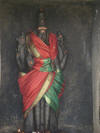 |
A decorative Lord Shiva |
 |
Ashai and Lindy at the Temple grounds |
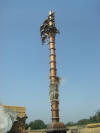 |
The Temple flagpole |
Next, we visited the museum located in the Tanjore Palace. It featured a variety of stone statutes and Bronze statutes dating from the 9th to 12th centuries. One feature of the Palace itself was very interesting. It appears to have a temple tower but it features no deities. It in fact was used to store the arsenal of the temple but mislead those originally looking at the palace into assuming it was a temple. Pretty smart!
Click on the image to display a larger photo. Once
displayed,
click on the BACK button (first button on the left of your browser)
to return to this page.
After our Palace visit, Ashai said goodbye to us for the day (we’ll once again be with her tomorrow). We did a bit of snack/beverage shopping and then Kadhar took us to a family-run bronze foundry. The men (father, son and brother) make bronze statutes using the lost-wax method. They showed us the process and then we purchased a lovely Parvati statute (Goddess of Power) to remember their work. Afterwards, we returned to the hotel with Kadhar and decided to relax for the balance of the day.
Mon, 3 Nov: We began early this morning, leaving the hotel at 8:00AM. We drove about 1.5 hours to the town of Trichy. After meeting Ashai, we visited the largest Hindu temple in India, Sriangam Temple, devoted to Lord Vishnu. It is a city within a city to say the least. The Temple consists of 156 acres of land with seven walls and 21 towers. The seven walls surround the temples and towers and they stretch a distance of nearly six miles. Cars are allowed within the first two fence areas. Afterwards, it is foot traffic only. We began our tour by climbing to a viewing point to enjoy a bird’s eye view of the complex. Then, we explored by foot. It took several hours due to the size of the compound.
Click on the image to display a larger photo. Once
displayed,
click on the BACK button (first button on the left of your browser)
to return to this page.
_small.jpg) |
A view of Sriangam Temple |
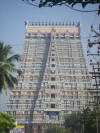 |
The North Gate entry |
 |
Lord Vishnu (The Protector God) |
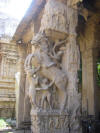 |
Isn't this column amazing! |
Next, we went to the Kaveri River, which is considered to be a holy river. We watched bathers, including one elephant and its mahouts, cleanse themselves in the river. We also witnessed several religious ceremonies. Also, individuals seeking guidance can consult with a counselor (there are numbered stands in which individuals offer their services). Afterwards, we took Ashai to the bus station for her long ride home to Bangalore. Then, we proceeded to take a three-hour drive to the city of Madurai.
Click on the image to display a larger photo. Once
displayed,
click on the BACK button (first button on the left of your browser)
to return to this page.
At 3:30PM we began our afternoon touring with Kadhar and our guide, Raja. We began first in the Thirumalayak Palace, a 16th century palace which originally was four times its present day size. Within the palace is a museum containing various sculptures and other artifacts. Next, we drove to the Meenakshi Temple, dedicated to Pavrati, the beautiful wife of Shiva. The temple was undergoing its 12-year repainting so all the towers were shrouded in cane scaffolding covered with banana leaves. However, we were able to enjoy the interior of many areas where non-Hindus were permitted. At the end of the visit, a Brahma priest met with us so that we could ask him questions about his role in the temple, how he became a priest, etc. It was very, very interesting!
Click on the image to display a larger photo. Once
displayed,
click on the BACK button (first button on the left of your browser)
to return to this page.
 |
En route to Madurai |
 |
A gate at Meenakshi Temple |
 |
Raja and Lindy in the Temple |
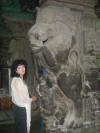 |
Lindy beside a huge carving |
 |
On the streets of Madurai, you
can get really fresh milk |
Later that evening, Kadhar took us into town to eat dinner at a local restaurant. It was fabulous! We ate several wonderful dishes using a banana leaf as our plate and our fingers as utensils (still the traditional way of eating in the typical Indian home). Our dishes included an onion salad, biryani, chicken marsala and spicy goat stew. Yummy!!
Tue, 4 Nov: We had a leisurely breakfast and began our day at 10:00AM with Kadhar being our driver and our guide. First, we drove by a temple which is located on an island in the center of a man-made pond. The pond is only filled with water in the rainy season. Then, individuals use boats to make their pilgrimages to the temple. Next, we visited a museum dedicated to Mahatma Gandhi and India’s fight for independence. It was fascinating! Early afternoon we had another delicious Indian lunch. We returned to the same restaurant as the prior evening and feasted on different dishes – onion salad; chana (ceci); squash; fish; biryani; and rice. Again, wonderful!
Click on the image to display a larger photo. Once
displayed,
click on the BACK button (first button on the left of your browser)
to return to this page.
 |
The temple and its moat |
 |
Mahatma Gandhi Museum |
 |
Enjoying our traditional lunch (unfortunately Kadhar got cut off in the photo) |
After an afternoon break, Kadhar picked us up at 5:00PM to enjoy the festivities
at Pazhamudhir Cholai, one of the six abodes of the 2nd son of Shiva,
Muragan. The temple is set in a small village outside of Madurai. As we drove
around the area, true to legend, we saw lots of peacocks – Muragan’s favorite
form of transport! We also took time out to feed some of the monkeys found at
one of the smaller temples in the area. Then, we enjoyed freshly-roasted
peanuts from a street vendor. Yum! Next, we drove to the temple which was
bursting with activity. Tons of families were walking in the streets enjoying
the festivities. The temple itself was decorated with lots of lights. It was a
great way to enjoy a taste of the real India! Thanks, Kadhar!!
Click on the image to display a larger photo. Once
displayed,
click on the BACK button (first button on the left of your browser)
to return to this page.
Wed, 5 Nov: We began this day of travel at 9:00AM. Kadhar drove us out of town en route to the Periyar Reserve. Most of the way, we drove through a large valley surrounded by mountains. It was a very fertile area with lots of crops being grown. Before entering the State of Kerala, we drove up a switchback which offered great views of the valley below. We arrived at our hotel about 1:30PM and immediately drove to the Reserve. There we took a boat ride on the lake and saw some wildlife. Afterwards, we went to a spice plantation in which virtually every known spice is grown. Late in the day, we settled into our cabana. We enjoyed local beer in the hotel bar and then watched a program of traditional dance. It was excellent and the great end to a wonderful day.
Click on the image to display a larger photo. Once
displayed,
click on the BACK button (first button on the left of your browser)
to return to this page.
 |
A herd of water buffalo |
 |
A small group of wild pigs |
 |
A couple of foxes (look
closely) on the banks of the river |
 |
Kadhar feeding a water buffalo |
 |
Traditional dancer |
 |
The show in process |
Thu, 6 Nov: We left our hotel at 8:30AM for a noon rendezvous with a houseboat which was to be our home for the afternoon/evening. En route we stopped at a flower garden and bought some basil seeds. Next, we came across a cattle/water buffalo auction. Then, at two different times, we had working elephants on the road. Pretty amazing!
Click on the image to display
a larger photo. Once displayed,
click on the BACK button (first button on the left of your browser)
to return to this page.
 |
Sharing the road |
 |
Rubber drying in the sun |
 |
A cattle auction in process |
 |
Sold! |
 |
Another elephant on the road |
Kadhar dropped us at 1:00PM and the adventure began. We boated for about an hour and then went to a small channel and moored. There we enjoyed a delicious lunch… rice, cabbage salad, green beans, sambar.… Great! After lunch we continued boating through the seawater canals. Just before dark, we reached the small village of Kavalam. We tied up for the evening. While the chef went shopping and subsequently prepared dinner, we walked about the town. We met several adults and tons of children. Then, we hired a small boat to take us through the channels surrounding the town. After an hour cruise, we returned back to our mother ship. Then, we had another delicious dinner featuring lentils, rice and bread complimented by cold Kingfisher beer. Wow! We called it a night about 9:00PM.
Click on the image to display a larger photo. Once
displayed,
click on the BACK button (first button on the left of your browser)
to return to this page.
Fri, 7 Nov: We awoke early this morning – in time to catch the sunrise – and then enjoyed a delicious breakfast on the front deck of the boat. We began motoring immediately and arrived at our drop off point at 9:00AM. Kadhar was waiting for us there. We bade farewell to the captain and crew (and boat owner who met us there) and we drove to Kochi, our final stop in southern India. We had an afternoon to relax. Then, at 4:30PM, Kadhar picked us up to go to a traditional Kathakali dance performance. We arrived early in time to see the individuals putting on their make-up. It was a great performance featuring two dancers, one singer and two drummers. Afterwards we returned back to the hotel for the evening.
Click on the image to display a larger photo. Once
displayed,
click on the BACK button (first button on the left of your browser)
to return to this page.
Sat, 8 Nov: This was our final day in Kochi as well as the State of Kerala. We had a late breakfast and then our guide, Roy, met us at the hotel. Kadhar drove us into the old area of Kochi. There we visited St. Francis Church, India’s oldest European-built church. Next, we went to the waterfront where the Chinese fishing nets are still in use by the fresh seafood market. After returning to the hotel and saying goodbye to Roy, we drove with Kadhar into the new part of the city. It was absolutely packed with shoppers. From there, we returned to our part of Kochi by ferry. It was a quick 10-minute ride. Finally, we visited Paradesi Synagogue which was built in 1568 by Spanish, Dutch and other European Jews. Its clock tower was added in 1760. It still serves as an active synagogue but it has very few members. Later that evening we enjoyed a farewell dinner with Kadhar at a local seafood restaurant. It was a great way to celebrate our 14 days of travel together!!
Click on the image to display a larger photo. Once
displayed,
click on the BACK button (first button on the left of your browser)
to return to this page.
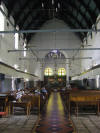 |
St. Francis Church |
 |
Chinese fishing nets |
 |
Fresh catch |
 |
Kadhar backing the car onto
the ferry while Ed walks beside the car |
 |
Paradesi Synagogue |
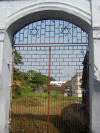 |
The Synagogue gate |
Sun, 9 Nov: We said a fond goodbye to Kadhar at the Kochi Airport at 10:30AM. It was sad to depart but we were glad he would be returning home (a two-day drive) to be with his wife and two daughters and other family members on Monday afternoon. We flew from Kochi to Mumbai and arrived at our hotel late afternoon. We got settled in and relaxed for the balance of the day.
Click on the image to display
a larger photo. Once displayed,
click on the BACK button (first button on the left of your browser)
to return to this page.
M U M B A I & A U R A N G A B A D
Mon, 10 Nov: Today we were joined by Mark Dagostino. He arrived in the early morning hours from North America. We all got together for breakfast at 8:30AM and then began touring about 9:30AM. Our guide, Tompi, and driver, Karim, met us at the hotel and we then proceeded into Mumbai. Like Kolkata, it is a huge town with many people coming in/out for work. We drove through many areas of the city and looked at some historic buildings. Highlights included going to a Jain Temple, seeing the “Gateway to India” monument and then visiting the “Thieves Market.” We also took some time out for a bit of shopping (at least Mark did). We returned to the hotel and all had dinner together. We made it an early evening since Mark had a bit of jet lag and we all had a 5:00AM wake-up to leave for the airport at 6:00AM.
Click on the image to display a larger photo. Once
displayed,
click on the BACK button (first button on the left of your browser)
to return to this page.
 |
Intricately carved and painted columns at the Jain Temple |
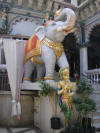 |
A decorative elephant at the Temple |
 |
Thieves' Market |
 |
Dhobi Ghat laundry area |
Tue, 11 Nov: Today we took an early morning flight from Mumbai to Aurangabad. When we arrived at 8:00AM, we were met by our guide, Thomas, and our driver, Fader. We first went to our hotel to check-in and drop off bags. Then, we headed out for the two hour drive to the Ajanta Caves. We had expected a cave (or two) and were so surprised to see a whole hillside of caves. These caves were cut from volcanic lava in a crescent shaped hillside. They were dug beginning in 200BC to 650AD to honor Buddha. The temples were lost after the 7th century and we were rediscovered by a party of British officers in 1819 when they were on a hunting expedition.
Click on the image to display
a larger photo. Once displayed,
click on the BACK button (first button on the left of your browser)
to return to this page.
The caves are truly amazing, especially when you consider the only tools used to create them were a chisel and a hammer. We wandered through the temples and enjoyed sculptures, wall and ceiling paintings and carved columns. Wow, it was amazing! We spent about four hours wandering from cave to cave enjoying the beauty and also learning about when each was constructed. We finished the caves at about 4:00PM and returned to the hotel at 5:30PM after enjoying a very full day.
Click on the image to display
a larger photo. Once displayed,
click on the BACK button (first button on the left of your browser)
to return to this page.
 |
The exterior of Cave No. 19 |
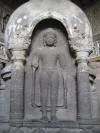 |
A large Buddha in Cave No. 19
|
 |
A reclining Buddha in Cave No. 26 |
 |
Fort walls that protect the cave area |
Wed, 12 Nov: We began our day at 9:00AM. Our first stop for the day was a 30KM drive to the Ellora Caves. These caves served as Buddhist monasteries during the 5th century (they were built during the 2nd and 6th centuries AD). This was another amazing site and is recognized as a World Heritage Site. Again, we were WOWED! We spent about five hours exploring some of the 34 caves. The most fascinating was the huge Kalish Temple, dedicated to Vishnu. Amazing!
Click on the image to display
a larger photo. Once displayed,
click on the BACK button (first button on the left of your browser)
to return to this page.
 |
An overview of Kalish Temple |
 |
Looking at more detail |
 |
A view of the Kalish Temple at ground level |
 |
An unsupported overhang |
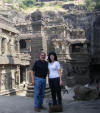 |
Us enjoying the setting |
We next visited the Aurangabad Caves which are located just outside town. These were built during the 7th century. They are not as large or dramatic as the Ellora or Ajanta Caves but again they were impressive since only a hammer and chisel created them. Our last stop of the day was at the mini-Taj Mahal. It was built over a 10 year period using marble for the base and domes and stucco for the balance of the structure. The building was designed by one of the rulers for the resting place of his mother. It was beautiful and a great warm up for the Taj Mahal in Agra.
Click on the image to display
a larger photo. Once displayed,
click on the BACK button (first button on the left of your browser)
to return to this page.
 |
The entry to Cave No. 7 |
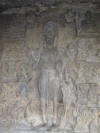 |
Inside Cave No. 7 |
 |
A great photo of the mini-Taj Mahal |
 |
Ed, Mark and Lindy at the mini-Taj |
Thu, 13 Nov: Happy 13th! Today was a travel day with some touring in Mumbai in between flights from Aurangabad to our final destination, Udaipur. We arrived in Udaipur at about 8:30PM and were transferred to our hotel. We called it an evening after checking in as we began at 5:30AM that morning and it was a long day.
U D A
I P U R, J O D P H U R & A G R A (THE TAJ MAHAL)
Fri, 14 Nov: Today we had a leisurely breakfast. At 9:30AM our guide, Vikram, met us in the lobby and we then joined our driver, Vipam, for a half-day of touring. We began by touring the beautiful city palace. The palace is still occupied by descendants of the State’s royal family. However, a museum has been established in part of the premises as have two heritage hotels. We spent a couple of hours wandering through the palace museum. The buildings were truly impressive as they shown only Hindu influences in their structure. That is, the area was not conquered by the Mongols (Persians) and thus no Islamic architecture is found in the royal buildings.
Click on the image to display
a larger photo. Once displayed,
click on the BACK button (first button on the left of your browser)
to return to this page.
 |
The Royal Residence inside the City Palace |
 |
The Museum |
 |
Decorative stain glass and
lattice inside the Museum |
 |
Us enjoying the rooftop garden at the Museum |
After visiting the palace, we then visited the gardens created for the females (queens and concubines) of the royal family. The grounds were beautiful and the fountains were spectacular.
Click on the image to display
a larger photo. Once displayed,
click on the BACK button (first button on the left of your browser)
to return to this page.
 |
The Garden of Maidens |
 |
Another fountain in the Garden of Maidens |
 |
Others enjoying the gardens (These ladies were gracious and allowed us to take their photograph wearing their beautiful saris.) |
We returned to the hotel in mid-afternoon and took an afternoon rest. Late in the day we visited the area where the hotel has a refuge for spotted deer, peacocks and wild boars. Afterwards, we enjoyed playing cards and having dinner before we called it an evening.
Sat, 15 Nov: We left Udaipur at 9:30AM. Our first stop was at Ranakpur where we visited the 500 year old Jain Temple. En route we saw and photographed woman carrying 30KG each of straw used as feed for the cattle. Then, we also shared the highway with a couple of camels.
Click on the image to display
a larger photo. Once displayed,
click on the BACK button (first button on the left of your browser)
to return to this page.
We arrived at the temple at 12:00 noon when it is open to visitors. It was built in the 15th century and is spectacular! The temple has numerous alcoves and statutes and over 1,400 beautiful hand-carved pillars. It’s still an active temple and we were allowed to photograph everywhere except for taking shots of the main Jain deity. Simply beautiful!
Click on the image to display
a larger photo. Once displayed,
click on the BACK button (first button on the left of your browser)
to return to this page.
 |
The Temple itself |
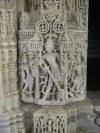 |
A close look at a beautifully carved column |
 |
Tiers of the Temple |
 |
The apex of the ceiling |
After viewing the temple we drove an additional three hours to Jodhpur and settled into our hotel for the night.
Sun, 16 Nov: Today we visited the sites of Jodphur, the “Blue City,” with our guide, Singh. Our first stop was Jaswant Thada, a cluster of memorials built to honor the dead in the royal family of the state. The most prestigious was a white marble building built by the wife of a king (she wasn’t burned alive at the death of her husband (the ordinary custom) because she was pregnant at the time).
Click on the image to display
a larger photo. Once displayed,
click on the BACK button (first button on the left of your browser)
to return to this page.
Our next stop was Mehrangarh Fort, founded in 1459 by the Rathore dynasty. The fort is built of red sandstone and sits on a 400 foot cliff above the city of Jodhpur. It has four gates approached by a long winding road. However, we choose the easy way up and accessed the Fort via an elevator. Then, we toured the various palaces located therein by working our way down from the top to the bottom. It was an impressive and massive structure which protected its owners.
Click on the image to display
a larger photo. Once displayed,
click on the BACK button (first button on the left of your browser)
to return to this page.
 |
The towering and impenetrable Mehrangarh Fort |
 |
An elephant seat used by royalty |
 |
An individual dressed in traditional garb |
We next visited the colorful street markets in the old part of Jodphur. We walked around this area for about an hour.
Click on the image to display
a larger photo. Once displayed,
click on the BACK button (first button on the left of your browser)
to return to this page.
After a short break at the hotel, we then went out into the countryside in an open jeep. First, we came across some of the Black Buck deer which are a protected species in the area. Then, we ventured into some of the local residences. First, we stopped at the home of a carpet maker. Next, we visited a village occupied by the Bishnoi, individuals who are dedicated to non-violence. We went into the home of family and were invited to enjoy a cup of water laced with some opium. Thanks, but no thanks. Lastly, we visited the home of a Muslim potter and watched him make three pots in a matter of a few minutes. Amazing!
Click on the image to display
a larger photo. Once displayed,
click on the BACK button (first button on the left of your browser)
to return to this page.
 |
A lone Black Buck |
 |
Cooking outside a village home |
 |
A potter at work at his wheel |
 |
A very productive potter! |
We returned to the hotel at 6:00PM covered with dust after a very long day. We again relaxed a bit before enjoying dinner at the hotel and then calling it a night.
Mon, 17 Nov: At 9:00AM, we left the hotel with our driver, Vipan, to begin the long trek to Jaipur. We drove primarily on two lane roads (often being made into four lane roads) until we were about 100KM from Jaipur. Then, we took a six-lane toll road to reach town. We arrived in Jaipur, the “Pink City,” at about 2:00PM and made it to our hotel by 2:30PM.
We began our touring at 3:15 with our guide, Mr. Singh. We began first at the Jantar Mantar, a stone observatory established by Maharaja Jai Singh II. There we found sun dials and a locator for the North Star. Next, we visited the City Palace, a former residence of the royal family. We walked through various courtyards where photography was allowed. We also went through galleries featuring art works, clothing, and weapons owned by the royal family. Here photography was not allowed. We finished at the City Palace at 5:30PM and returned to the hotel for dinner.
Click on the image to display
a larger photo. Once displayed,
click on the BACK button (first button on the left of your browser)
to return to this page.
 |
The garden at Jantar Mantar |
 |
A sundial |
 |
Individual zodiac stairs |
 |
Workers at the City Palace |
 |
The courtyard at the City Palace |
Tue, 18 Nov: This morning we set out very early for the Amber Fort, the former capital of the area before the Maharaja moved his palaces and established the current city of Jaipur. The Fort sits on a steep hill so we accessed it via the back of an elephant. Pretty nifty! Then, we spent several hours exploring the Fort and its various rooms. The Maharaja and his wives (yes, plural) and concubines (he needed those girlfriends too) lived a very good life. They enjoyed great food, a beautiful palace, live entertainment and even water-cooled air during the summer months. From the Fort, we also had terrific views of the “Great Wall of India,” the huge wall built to protect the city. It is about eight feet wide and includes watch towers. It’s no wonder the city was well protected!
Click on the image to display
a larger photo. Once displayed,
click on the BACK button (first button on the left of your browser)
to return to this page.
 |
The ascent to Fort Amber |
 |
Mark taking the easy way up |
 |
The entry gate to the Fort |
 |
A close-up of the beautiful Fort walls |
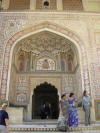 |
A gate dedicated to Ganesha |
 |
Two snake charmers and a very active snake |
Wed, 19 Nov: We had another early start this morning as we had a four-hour drive to reach our next destination, Ranthambore National Park. Vipan took a short-cut through some small villages so we actually arrived slightly ahead of schedule before 12:00 noon. After settling into our accommodation just outside the Park (Tiger Den Resort), we enjoyed lunch at the resort before our first game drive.
We went into Ranthambore National Park via jeep at 2:30PM. After our guide completed the necessary paperwork at the Park gate, our adventure began. First, we were greeted by some Black Faced Macaque Monkeys. Then, we began driving on the park roads (FYI, this was once a private hunting ground for the Maharaja and his privileged guests; it was not protected until the 1950’s and not a park until 1972.) We came across the two types of deer found in the Park – Sambar Deer and Spotted Deer. Next, at a waterhole, we had our first sighting of wild boars. We saw lots of birdlife throughout the drive. At the end of the drive (early evening), we came across two leopards sitting on a bluff. Unfortunately, it was too late to take photographs but we did enjoy viewing these lovely creatures via binoculars. We left the park and we returned to our hotel around 6:15PM.
Click on the image to display
a larger photo. Once displayed,
click on the BACK button (first button on the left of your browser)
to return to this page.
Thu, 20 Nov: Today we began our first safari at 6:15AM. It was quite dark and the sun was only beginning to peak out from the horizon as we entered Ramthambore National Park. We again had some great game viewing. In addition to seeing deer, boars and monkeys, we also saw our first Indian Gazelle and Indian Antelope. We stayed in the park until 9:30AM but did not manage to see any Tigers. Our afternoon safari began at 2:00PM. We didn’t encounter nearly as much game as we had seen in the morning. However, we enjoyed the animals we did see and we reflected on where we were and how few individuals get to enjoy this wonderful park. We returned back to the hotel at 6:00PM which was just enough time to get ready for another game of cards before having dinner at 7:30PM. We called it a night at 8:30PM since we once again had an early morning departure (6:15AM).
Click on the image to display
a larger photo. Once displayed,
click on the BACK button (first button on the left of your browser)
to return to this page.
Fri, 21 Nov: Today we had a new adventure. We were transferred from our hotel to the train station at 6:30AM. There was incredible fog and we all ended up a bit soggy since we drove to the station in an open jeep. Oh well! After a weather delay due to the fog, we boarded a train to Bharatpur. Upon arrival we were met by Vipan who previously had collected all our luggage except for overnight bags to ensure our first train ride in India was hassle-free.
We began our touring after about a one hour drive. We stopped at Fatehpur Sikri, a capital city and fort built in 1569 and abandoned 15 years later due to a water shortage. Here we visited the Hall of Public Audiences as well as the Hall of Private Audiences. We also visited the interior palaces built for the three wives of the emperor. We enjoyed strolling through the area with its great stone carvings on the pillars and walls of the sandstone edifices.
Click on the image to display a larger photo. Once
displayed,
click on the BACK button (first button on the left of your browser)
to return to this page.
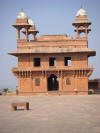 |
Fatehpur Sikri |
 |
Us in the Public Hall |
 |
An alligator/elephant arch |
 |
A hallway in the compound |
 |
A mosque inside Fatephur Sikri |
Afterwards, we drove into Agra, our home for the next two nights. Given it was late afternoon, we opted not to do any additional touring. Instead, we relaxed at the hotel, walked to a nearby mall, enjoyed some down time and made it an early night.
Sat, 22 Nov: Today we had another early start as we met our guide, Pablo, at 6:00AM in the hotel lobby. Our quest was to view the Taj Majal at sunrise. We arrived at the East Gate of the Taj Mahal at about 6:30AM and there was already a short queue. We waited until 7:45AM before the gate was opened. We first entered an interior compound. Then, we walked to its center and passed through an archway. There, we saw our first real-life look at the Taj Mahal. Despite seeing numerous photographs and drawings of this monument, it can’t compare to seeing it in person. It’s much bigger than we had imagined and despite the number of people, the interior compound didn’t seem crowded. We were able to enjoy numerous views of the Taj Mahal and also get some great photographs!
Click on the image to display
a larger photo. Once displayed,
click on the BACK button (first button on the left of your browser)
to return to this page.
 |
Our first glimpse of this incredible structure! |
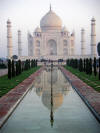 |
The sun continues to rise and the Taj Mahal becomes even more beautiful! |
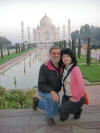 |
We made it! |
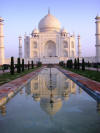 |
The best for last! |
We returned back to the hotel for breakfast and a break until 2:00PM. Then, we went to see Agra’s second World Heritage Site, the Agra Fort (the Taj Mahal is Agra’s first and foremost World Heritage Site). It too was a very impressive structure.
Click on the image to display
a larger photo. Once displayed,
click on the BACK button (first button on the left of your browser)
to return to this page.
 |
The gate at Fort Agra |
 |
The towers at Fort Agra |
 |
The stunning King's Palace inside the Fort |
 |
Now that's a window! |
Afterwards, we once again visited the Taj Mahal at sunset. It is truly a spectacular monument to true love.
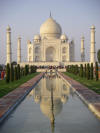 |
The crowds are now enjoying this beautiful monument |
 |
Yes, another shot of us but a
slightly different view of the Taj Mahal |
 |
The Taj Mahal through an arch |
Sun, 23 Nov: Today was both a day of travel and touring. We left the hotel at 7:30AM and we said goodbye to Vipan at the Agra Railway Station. There, we caught a train to Jsania, a 2.5 hour ride. When we arrived there, we were met by our new driver, Oshak. We then drove to the town of Orchha. We toured the Jehangier Mahal, a tiered palace built by the Maharaja for a Mughal visitor. Then, we visited the Raja Mahal which contained amazing frescos portraying numerous religious scenes. This temple originally was constructed to house Lord Rama but instead his idol was placed in the Queen’s Palace. So this beautiful building ultimately became dedicated to Lord Vishnu. Truly amazing! We then had a delicious vegetarian lunch at a local hotel. At about 3:00PM, we drove to Khajuraho, our home for the next two nights. We arrived at 6:00PM and were truly exhausted. So, we had an early evening.
Click on the image to display
a larger photo. Once displayed,
click on the BACK button (first button on the left of your browser)
to return to this page.
 |
An overview of Jehangier Mahal (remember, this was built for a guest) |
 |
The interior courtyard |
 |
Elephant carvings used as supports |
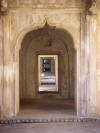 |
The beautiful hallways |
.003_small.jpg) |
An area dedicated to Lord Vishnu |
K H A J U R A H O & V A R A N A S I
Mon, 24 Nov: This morning we drove about 1.5KM to reach the Khajuraho Temples. We first visited the Western Group of Temples. This is an unbelievable complex of five primary temples which represent some of the finest examples of temple structures in Northern India. They remained intact because they were “lost” from the time of their construction (950AD – 1050AD) and overgrown with jungle vegetation. They were re-discovered by the British and, as such, are in near perfect condition since no subsequent rulers destroyed them. Part of their fame lies in the many erotic poses which can be found among the decorative statutes.
Click on the image to display
a larger photo. Once displayed,
click on the BACK button (first button on the left of your browser)
to return to this page.
Next, we visited the Eastern Group of Temples. There are two temples located here which also are beautiful. We enjoyed having the area to ourselves as large groups don’t often visit these temples since they are near the old village and parking is at a premium. Here too a bit of erotica is part of the temple motifs.
Click on the image to display
a larger photo. Once displayed,
click on the BACK button (first button on the left of your browser)
to return to this page.
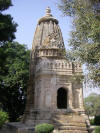 |
Adinath Temple |
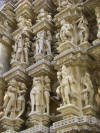 |
A closer view of the carved walls of Adinath Temple |
 |
Parsvanatha Temple |
 |
A closer view of the carvings |
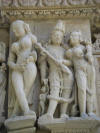 |
Pretty amazing bodies! |
After a mid-day break (and we needed one after the sites we just saw), we visited the village of Khajaraho. It featured narrow streets with small homes and/or shops. We visited one home and one shop. At the latter we did purchase some locally made jewelry.
Click on the image to display
a larger photo. Once displayed,
click on the BACK button (first button on the left of your browser)
to return to this page.
That evening we returned to the Western Group of Temples. There we enjoyed a light and sound show which highlighted the history and building of the temples. It was very well done and we thoroughly enjoyed ourselves.
Tue, 25 Nov: Today we left the quiet village of Khajaraho and flew to the ancient city of Varanasi. We arrived mid-afternoon and transferred to our hotel. First we drove to the village of Sarnath, about 12KM from Varanasi, where we visited the area where Buddha preached his first sermon after his enlightenment. It had relics of buildings which had been destroyed by Muslim invaders. However, one large stuppa remains intact albeit with some reconstruction. Many artifacts were kept in a very nice museum on the property (no photographs allowed). Then, late afternoon we drove into the center of the city. Once there we took a boat ride on the Ganges River and witnessed the evening prayer service. Afterwards, we returned to the hotel and had dinner in anticipation of an early morning the next day.
Click on the image to display
a larger photo. Once displayed,
click on the BACK button (first button on the left of your browser)
to return to this page.
 |
The grounds and stuppa in Sarnath |
 |
A closer view of the huge stuppa |
 |
Carving details on the stupps |
 |
An evening prayer service on The Ganges River |
Wed, 26 Nov: This morning we began at 5:30AM. We once again returned to the Ganges River for a boat ride. This morning we watched pilgrims “purify” themselves by bathing in the river. We also saw several Brahma priests who were blessing the pilgrims. Upon leaving the boat, we walked the narrow back alleyways of Varanasi. It was an amazing adventure. We really saw how the individuals live and work in this area. En route, we saw one wedding procession and two other processions where dead bodies were being carried to the crematorium. You don’t witness either of those events on any U.S. street at 7:30AM!
Click on the image to display
a larger photo. Once displayed,
click on the BACK button (first button on the left of your browser)
to return to this page.
 |
Dawn on The Ganges River |
 |
A decorative temple on The Ganges |
 |
A priest holding a ceremonial flame |
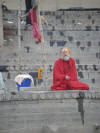 |
Another priest at the Temple |
 |
Pilgrams bathing in The Ganges |
 |
Varanasi wakes up |
 |
A typical street |
After leaving the downtown area, we drove to the Hindu University. After viewing various campus buildings, we went to a Hindu Temple on the campus. Then, we went back into the western part of Varanasi to visit the Temple of India. It contains a relief map of the Indian subcontinent that was chiseled out of marble in the 1930’s. It was a work of art and very interesting to see all the various places we had visited. We then finished our touring for the day. We returned back to the hotel for a late breakfast. Then, Mark gathered up his belongings and he was transferred to the Varanasi airport for his flight to Delhi. After a day tour in Delhi on the 27th, Mark returned to the U.S.
Click on the image to display
a larger photo. Once displayed,
click on the BACK button (first button on the left of your browser)
to return to this page.
TO VIEW OUR TRAVEL
ADVENTURE IN NEPAL BEFORE OUR FINAL
TOURING IN NEW DELHI, CLICK ON THIS LINK;
THE REST OF OUR STAY IN INDIA FOLLOWS
BELOW.
Tue, 2 Dec: After a very enjoyable stay in Nepal, we returned to spend the
final days of this adventure back in India. We arrived in the capital of New
Delhi at about 6:00PM. It took about 1.5 hours to clear the airport
(immigration & customs was a breeze; the delay was in receiving our baggage; we
were told extra security measures were in effect). We arrived at our hotel at
about 9:00PM, settled in and called it an evening.
Wed, 3 Dec: We began our first day of touring with our guide, Arouk, and our driver, Sonny. Our first stop was Raj Ghat, a memorial dedicated to Mahatma Ghandi. It was a very beautiful spot. Then, we drove to see India Gate. Built in 1931, it stands the height of a 20 story building. It is a war memorial and an eternal flame burns at its base. Afterwards we drove through the governmental and courts area. We stopped briefly outside the Presidential Palace for photographs. We also stopped outside the Parliament House. We next visited Jama Masjid, India’s largest mosque which was built in 1656. We then took a bicycle rickshaw ride through the narrow streets of Old Delhi.
Click on the image to display
a larger photo. Once displayed,
click on the BACK button (first button on the left of your browser)
to return to this page.
We spent our afternoon at two spots. The first, Qutub Minar, which was built in 1199. The Minar (tower) is 72 meters tall and is the mainstay of the complex. The surrounding buildings in the complex contain pillars taken from Hindu temples for use in the Muslim construction (all idols on the pillars were first defaced). One 5th century iron pillar, dedicated to Lord Vishnu, was spared since no one was able to interpret its origins.
Click on the image to display
a larger photo. Once displayed,
click on the BACK button (first button on the left of your browser)
to return to this page.
 |
Qutub Minar |
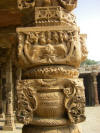 |
The pillar dedicated to Lord Vishnu |
 |
Other pillars comprising the compound |
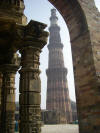 |
A final look at the Minar |
Our final stop of the day was at the tomb of Emperor Humayan. It is considered to be the architectural precursor to the Taj Majal. It was indeed very beautiful and very reminiscent of the Taj.
Click on the image to display
a larger photo. Once displayed,
click on the BACK button (first button on the left of your browser)
to return to this page.
Thu, 4 Dec: This was our final day of touring on this trip to India. We went to two separate temple complexes. The first was the Akshardham Temple. It is a large complex dedicated to the Swaminarayan Askhardham believers (no photographs were allowed). Our second stop was at the Baha`i Temple which hopes to bring divergent thoughts and religions into one school of thought. After reviewing these two sites, we returned to the hotel for a relaxing evening.
Click on the image to display
a larger photo. Once displayed,
click on the BACK button (first button on the left of your browser)
to return to this page.
Fri, 5 Dec: Today we strolled around the neighborhood near our hotel. Then, at 8:00PM in the evening, we transferred to the airport for our long journey home.
India was indeed INCREDIBLE! We enjoyed the many sights we visited and the people with whom we interacted. We hope others have the opportunity to enjoy this great land!